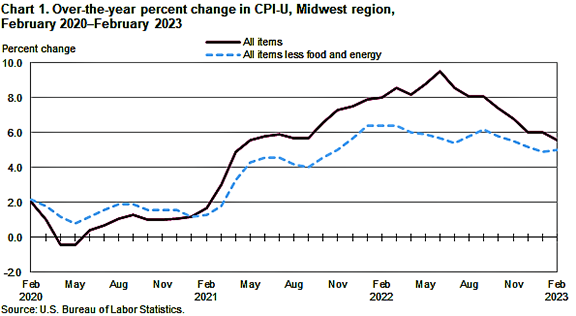KANSAS CITY, Kans. – Prices in the Midwest Region, as measured by the Consumer Price Index for All Urban Consumers (CPI-U), advanced 0.5 percent in February, the U.S. Bureau of Labor Statistics reported today.
The all items less food and energy index increased 0.6 percent, led by an increase in the index for owners’ equivalent rent of residences. Food prices increased 0.3 percent over the month. A decline in the index for energy (-1.0 percent) was almost entirely driven by falling natural gas service prices. (Data in this report are not seasonally adjusted. Accordingly, month-to-month changes may reflect seasonal influences.)
Over the last 12 months, the CPI-U advanced 5.6 percent. (See chart 1.) The index for all items less food and energy increased 5.0 percent over the year, while food prices advanced 10.2 percent. Energy prices rose 2.8 percent over the same period.

Food
Food prices increased 0.3 percent for the month of February. Prices for food at home (grocery store products) similarly rose 0.3 percent, while prices for food away from home (restaurant, cafeteria, and vending purchases) advanced 0.4 percent for the same period. Within the food at home category, prices paid for nonalcoholic beverages and beverage materials (+1.6 percent) and other food at home (+0.7 percent) contributed most to the over-the-month increase. Declining prices for fruits and vegetables (-0.7 percent) somewhat moderated these increases.
Over the year, food prices advanced 10.2 percent. Prices for food at home rose 10.8 percent since a year ago, with all six major grocery store food group indexes contributing to the rise. The other food at home index (which includes sugar, sweets, fats, and oils) contributed the most to the rise at 14.0 percent. Prices for food away from home rose 9.3 percent over the same period.
Energy
The energy index fell 1.0 percent over the month. The decrease was almost entirely due to lower prices for natural gas service (-5.7 percent), but the index for electricity also declined (-0.1 percent). An increase in the index for gasoline (+0.2 percent) somewhat offset these decreases.
From February 2022 to February 2023, energy prices rose 2.8 percent, largely due to higher prices for electricity (+7.2 percent) and natural gas service (+6.6 percent). Partially offsetting the rise was a decrease in prices paid for gasoline (-1.2 percent) for the same period.
All items less food and energy
The index for all items less food and energy advanced 0.6 percent in February. The over-the-month increase was most driven by higher prices for owners’ equivalent rent of residences (+0.6 percent), household furnishings and operations (+1.8 percent), and apparel (+3.6 percent). Partially offsetting the rise were declining prices paid for used cars and trucks (-1.5 percent) and medical care services (-0.3 percent).
Over the year, the index for all items less food and energy increased 5.0 percent. The largest component contributing to the increase was owners’ equivalent rent of residences (+6.7 percent), establishing a new series high. Increases to rent of primary residence (+7.2 percent), and household furnishings and operations (+7.3 percent) also made notable contributions. Partly offsetting these increases was a decline in prices paid for used cars and trucks (-13.7 percent).
